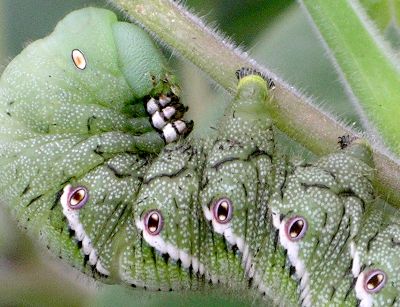
Tobacco Hornworm (Manduca sexta) with one thoracic and five abdominal spiracles visible.
This brief look at the functions related to comparative anatomy came on top of a revelation I had while teaching an entomology class a few weeks ago. While I always spend some time discussing the external characteristics and development of insects at the beginning of each course, I don't usually go into depth about how arthropod bodies actually work. Luckily, one student was quite interested in such questions and so steered our discussions into things like the peculiarities of insect movement, senses, digestion, circulation and breathing. I immediately realized that this material was of great interest, but not at all common knowledge, to folks with only cursory prior instruction in biology.
Vertebrates and arthropods do have analogies. It is fairly straightforward to see how muscles can attach to an exoskeleton as effectively as to an internal framework. It's also obvious that food goes in the mouth and waste comes out the other end, whether for a horse or a beetle. Insects might not collect information about their environment in quite the same way as cats or fish do, but they still have eyes for sight, ears for sound, and receptors for smell and taste. Perhaps one of the most mysterious aspects of insects, though, is how their internal organs manage to get enough oxygen without lungs.
 Tobacco Hornworm (Manduca sexta) with one thoracic and five abdominal spiracles visible. |
When it comes to gas exchange (oxygen in, carbon dioxide out), the most obvious difference about insects is that they do not breathe through holes in their head, like we do. They do not have anything on their face that functions like a nose for inhaling. If insects were our intellectual equivalents, they would never have invented the phrases "clear as the nose on your face," "keep your nose out of my business," and "it's right under your nose!" Of course, they would probably instead have created snide remarks about our head holes.
So, where does the air enter a bug? The answer is relatively simple: through openings called spiracles in the sides of their bodies. As might be expected in a class of animals as diverse as insects, one size does not fit all. The number of spiracles varies from twenty to none. The most that any insect has is ten pairs, with two pairs on the thorax (middle segment of the body) and eight on the abdomen. Spiracles are round openings that can be opened or closed by a valve. When they are open, air enters the tracheal tubes, which start out fairly thick at the surface then branch and narrow throughout the body, reaching all organs and tissues. The air in the tracheae delivers oxygen and also transports carbon dioxide and water vapor that are the waste products of the cells. This is basically a passive system, but in species with higher metabolic needs, such as flies and bees, the air can be pushed in and out faster by muscle movements. If you want to see an example, chase a large grasshopper in an open area for a bit. You will have to follow it for several minutes until it tires and can finally be caught. At this point, it is possible to see the abdomen pulsing just like a lizard's chest heaving after it has sprinted from danger. The spiracles are wide open (although they are so tiny, this is hard to see) and the insect is pushing air in and out as fast as it can to replenish the oxygen within its cells.
If an air breathing bug is dropped into water, it will close the spiracles to keep water from entering. If it cannot get to a solid surface, it will eventually suffocate for lack of oxygen. If you put a fly's head underwater, it will survive for quite some time because it is breathing through the sides of its body. But what about aquatic insects? Well, they have several options, depending on their anatomy. Some, like water beetles, maintain a bubble of air around their bodies. They need regular trips to the surface to replenish the supply. Mosquito larvae have only one spiracle and it is on their butt. That is why they all hang from the surface of the water unless disturbed. I mentioned earlier that some insects do not have any spiracles. They have what is called a closed tracheal system. Mayfly nymphs have this feature, along with feathery looking gills on their abdomens for gas exchange with the water. Dragonfly nymphs also have gills but they are not visible. What they are called says it all: rectal tracheal gills. Myriad parasitic insects that develop within another arthropod have cutaneous gas exchange, or basically breathe through their skin.
For many people, knowledge of the arthropod world comes primarily from science fiction movies about giant spiders and moths (impossibilities in many ways, including the limitations imposed by the amount of oxygen in our atmosphere and the weight of the exoskeleton) and cartoons (ants that have males living in the colony, not to mention being able to talk and even tell jokes!). But knowing a bit about real insect physiology does have benefits, even if only to aid us in our constant battle for the limited resources on this planet. When trying to get rid of aphids on cultivated plants without resorting to toxic chemicals, it makes sense to spray them with water with a bit of dishwashing detergent. The soap helps break down the waterproofing waxy coating on the insects so that they can more easily drown.